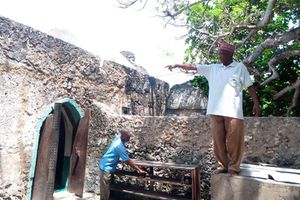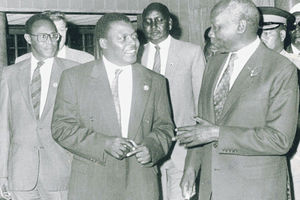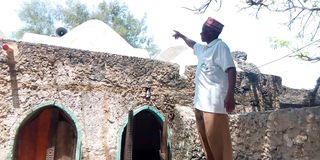
Hamisi Suleiman, caretaker, shows the design of the iconic Kongo Mosque in Diani, Kwale County.
At the shores of the Indian Ocean in Diani where the river meets the sea at Mwachema River tributary commonly known as Kongo River, an ancient mosque lies on the beach.
The Kongo Mosque, that is believed to date back to the 14th century, is believed to be one of the oldest mosques in East Africa, having been used by Persians and a key entry point for trade.
Its coral stone walls and ancient baobab trees surrounding the site make it a rare historical object of Islamic history.
For years, the mosque has become a critical place of worship.
Every Friday and other notable Islamic holidays, Muslim faithful flock the house of worship and often spill towards the beach to conduct their prayers.
Being near a public beach, the mosque custodians always ensure that the Islamic religious traditions are observed.
For instance, right at the entrance, they have placed a warning sign restricting loud music and nudity near the mosque which neighbors the beach.
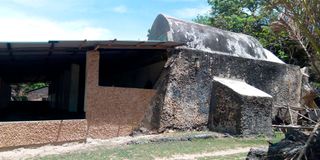
Part of the ancient Kongo Mosque in Diani, Kwale County.
When you arrive at the mosque, the first point of attraction is two gigantic graves, bigger than normal ones.
According to the mosque custodians, Arabs from Persia were conducting their trade in East Africa on the Indian Ocean when they made a stop at the area, building the mosque with their skills.
"They stayed here for over a year and that's why they had to build a mosque and use it," said Sheikh Amani Mwachirumo.
The traders were led by an African named Sadiq Kongo, who is believed to be the first Imam of the mosque. Sadiq and other traders who died were buried next to the mosque, hence the huge graves.
Sheikh Mwachirumo narrated that the Persians let Sadiq accompany them as an African to ensure the communities are not hostile to them.
Omar Kisinyo, another Imam at the mosque explained that the height of those who dwelled there was above average, hence the height of the mosque.
"There is a place within the mosque where they used to place their 'bakoras'. This tells you that they were very tall people.
Inside the mosque, the unique architecture, though rustic, stands out. The custodians reveal an overhead tank where he said the dwellers would store their water. It's walls, though painted white were made coral stones.
After some of the traders left, the mosque was left to the Mijikenda community who used it to conduct traditional rituals of cleansing or special prayers.
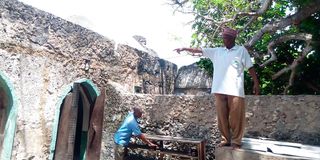
Hamisi Suleiman, caretaker, shows the design of the iconic Kongo Mosque in Diani, Kwale County.
This was until 1932, when Kongo Mosque officially began offering Muslim Prayers through Sheikh Mwanyikombo.
In 1983, it was considered and gazetted as a national monument by the National Museums of Kenya, and has since been a key tourist attraction with locals hoping that it remains a major symbol of their past and tradition for generations to come.
Continued use of the mosque and an increase in population has led to it's expansion, with some of the cracked walls renovated.
It also a key attraction, as many tourists who would want to understand the Muslim history are guided through the building.
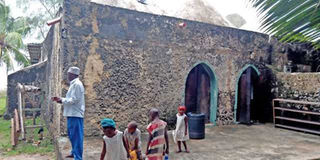
Kongo mosque. The name was derived from a name inscribed on a stone at one of the graves in the mosque compound, where Muslim faithful Swaddiq Kongo was buried centuries ago. PHOTO | FADHILI FREDRICK | NATION MEDIA GROUP
However, its religious, economic and cultural significance is now threatened by land grabbers according to Muslim religious elders.
“We do not recognize this title that in all those years, we have come to know about it in 2023. This is a highly marketable beachfront property and in case it is sold to investors, they may set up businesses that go against our religious beliefs and culture,” said Omar Kisinyo, the Imam at Kongo Mosque during a recent interview with journalists at the Mosque.
He also said that the grounds were critical to the Muslim community, who are the majority in Msambweni, for setting up youth friendly football grounds to help promote cohesion.
Meanwhile, Kwale Governor Fatuma Achani promised that she will not allow the land belonging to the Muslim community end up in the hands of private individuals.
He said already, officers from the Ethics and Anti-Corruption Commission (EACC), Directorate of Criminal Investigations (DCI) and National Land Commission (NLC) were working to investigate the issue after preventing its sale.
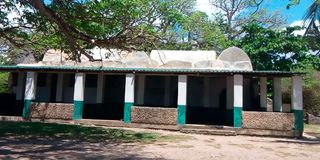
Part of the ancient Kongo Mosque in Diani, Kwale County.
At the same time, the Muslim community have moved to court to revert the ownership of Kongo Mosque to the local Muslim community.
This is after two individuals claimed ownership of the property and listed it for sale for Sh1.4 billion.
The move has also elicited anger from locals who frequently use the public beach during weekends, public holidays and boat operators who take tourists on sunset dhows on the famous Kongo River in the evenings.

